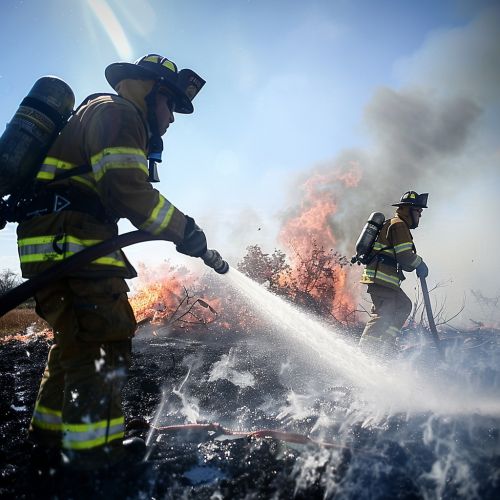Fire services in the United Kingdom
Overview
Fire services in the United Kingdom are responsible for providing emergency response to fires, road traffic collisions, and other emergencies. They also engage in fire prevention, education, and enforcement of fire safety regulations. The fire services operate under various legislative frameworks and are organized into regional fire and rescue services (FRS).
History
The history of fire services in the United Kingdom dates back to the Great Fire of London in 1666, which highlighted the need for organized firefighting efforts. The first insurance company fire brigades were established in the late 17th century. The Metropolitan Fire Brigade Act of 1865 led to the formation of the London Fire Brigade, and subsequent legislation expanded organized fire services across the country.
Structure and Organization
The fire services in the UK are organized into regional fire and rescue services. Each FRS is responsible for a specific area and operates under the jurisdiction of local authorities. The National Fire Chiefs Council (NFCC) provides leadership and coordination at the national level.
Governance
Fire and rescue services are governed by local fire authorities, which are typically composed of elected officials from local councils. These authorities are responsible for setting budgets, policies, and strategic priorities for their respective fire services.
Funding
Funding for fire services comes from a combination of local council tax, government grants, and other sources. The financial resources are allocated to cover operational costs, equipment procurement, training, and community safety initiatives.
Operations
Fire services in the UK provide a wide range of emergency response and prevention services. These include firefighting, rescue operations, hazardous materials response, and fire safety education.
Firefighting
Firefighting is the core function of the fire services. Firefighters are trained to respond to various types of fires, including residential, commercial, industrial, and wildfires. They use specialized equipment such as fire engines, hoses, breathing apparatus, and thermal imaging cameras.


Rescue Operations
Fire services also conduct rescue operations, including extrication of individuals from road traffic collisions, water rescues, and urban search and rescue (USAR). These operations require specialized training and equipment, such as hydraulic rescue tools and inflatable boats.
Hazardous Materials Response
Fire services are equipped to handle hazardous materials incidents, including chemical spills, gas leaks, and radiological emergencies. Firefighters receive training in hazardous materials (HAZMAT) response and use protective suits, decontamination equipment, and monitoring devices.
Fire Safety Education
Fire safety education is a key component of fire services' efforts to prevent fires and reduce casualties. Firefighters and community safety officers deliver educational programs in schools, workplaces, and community centers. These programs cover topics such as fire prevention, escape planning, and the proper use of fire extinguishers.
Training and Professional Development
Firefighters undergo rigorous training to prepare for their roles. Initial training programs cover firefighting techniques, rescue operations, first aid, and fire safety. Ongoing professional development ensures that firefighters stay current with new technologies, procedures, and regulations.
Training Facilities
Training facilities for fire services include fire stations, training centers, and specialized training grounds. These facilities are equipped with simulators, live fire training props, and classrooms for theoretical instruction.
Qualifications
Firefighters in the UK typically complete a Level 3 Diploma in Emergency Fire and Rescue Services, which is accredited by the Institution of Fire Engineers (IFE). Additional qualifications and certifications are available for specialized roles, such as fire investigation and fire safety inspection.
Legislation and Standards
Fire services in the UK operate under a comprehensive legislative framework that includes the Fire and Rescue Services Act 2004, the Regulatory Reform (Fire Safety) Order 2005, and the Civil Contingencies Act 2004.
Fire and Rescue Services Act 2004
The Fire and Rescue Services Act 2004 outlines the statutory duties of fire services, including firefighting, rescue operations, and fire safety enforcement. It also provides for the establishment of fire authorities and the appointment of chief fire officers.
Regulatory Reform (Fire Safety) Order 2005
The Regulatory Reform (Fire Safety) Order 2005 consolidates various fire safety regulations into a single framework. It places a duty on responsible persons to ensure the safety of occupants in non-domestic premises by conducting fire risk assessments and implementing appropriate fire safety measures.
Civil Contingencies Act 2004
The Civil Contingencies Act 2004 establishes a framework for emergency preparedness and response. It requires fire services to collaborate with other emergency services and local authorities to plan for and respond to major incidents.
Challenges and Future Directions
Fire services in the UK face several challenges, including budget constraints, evolving risks, and the need for modernization. Climate change, urbanization, and technological advancements are driving changes in the types of incidents fire services must respond to.
Budget Constraints
Budget constraints have led to reductions in staffing levels and resources for some fire services. This has prompted calls for increased funding and investment in fire services to ensure they can meet current and future demands.
Evolving Risks
Evolving risks, such as climate change and terrorism, require fire services to adapt their capabilities and strategies. Wildfires, flooding, and chemical attacks are examples of emerging threats that fire services must be prepared to address.
Modernization
Modernization efforts focus on improving the efficiency and effectiveness of fire services through the adoption of new technologies, such as drones, advanced communication systems, and data analytics. These innovations enhance situational awareness, decision-making, and resource allocation.
